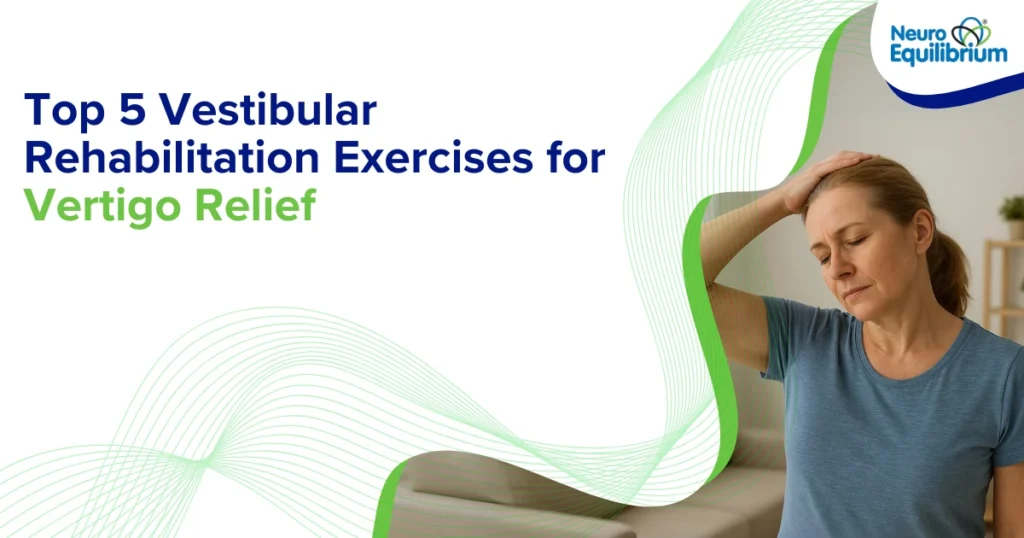Experiencing vertigo can be disorienting like the room is spinning or your balance is betraying you, even though you’re standing still. But here’s the key thing to understand: vertigo itself isn’t the problem; it’s a signal that something deeper is going on.
Think of vertigo like the check engine light in your car. The light doesn’t tell you exactly what’s wrong; it just means something in the system isn’t functioning as it should. Maybe it’s a minor issue, or perhaps it’s something more serious. Similarly, vertigo can be caused by something as common and treatable as Benign Paroxysmal Positional Vertigo (BPPV) or it could point to a range of over 40 possible disorders affecting the inner ear, brain, or other systems in your body.
To treat vertigo effectively, you first need to diagnose what’s triggering it. We will try to help you understand the signs of BPPV and how to tell if your symptoms may point to something else that needs attention.
Know More About BPPV
- BPPV Treatment: Effective Ways to Manage Vertigo
- BPPV Maneuver Guidance System
- Just Diagnosed with BPPV? Here’s what to do Next?
What Is BPPV?
Benign Paroxysmal Positional Vertigo (BPPV) is the most common reason people experience vertigo. It happens when tiny calcium carbonate crystals, called otoliths, move from their usual spot in your inner ear and get into the fluid-filled semicircular canals. When you move your head, these displaced crystals act like a small piston, forcefully moving the fluid in your inner ear, which then causes those sudden, intense spinning sensations.
BPPV often occurs without a clear reason, but it can also follow injuries, long periods of bed rest, surgery, or even unusual head positions during exercise. It’s more common in older adults. The good news is that BPPV is very treatable and often goes away completely with the correct maneuver.
Common Symptoms That Suggest BPPV
If you have BPPV, you’ll likely notice some specific patterns:
- Vertigo triggered by particular head movements: This is the most telling sign. You might feel dizzy when turning in bed, bending over to pick something up, or looking up or down.
- Episodes that last less than 30 seconds: The spinning sensation is usually brief, reducing in intensity in under a minute.
- No vertigo when your head is still: When your head is not moving, you typically feel fine.
- Normal hearing and no ringing in the ears: BPPV usually doesn’t affect your hearing.
- No headache, blurred vision, or limb weakness: These are not typical BPPV symptoms.
- Feeling fine between episodes: You generally feel normal in between the short bouts of vertigo.
BPPV is typically diagnosed through positional tests like the Dix-Hallpike or Supine Roll Test, especially under Videonystagmography (VNG) guidance using high-speed infrared cameras. This helps determine the exact location of the crystal and the type of BPPV, as there are 14 different variants.
Other Conditions That May Cause Vertigo
If your vertigo doesn’t fit the BPPV pattern, or if you have additional symptoms, the cause might be something else. Many other conditions can cause vertigo, and they often have different symptoms, durations, and diagnostic approaches.
| Condition | Symptoms |
| Meniere’s Disease | Vertigo episodes last hours, with fluctuating hearing loss, tinnitus (ringing in the ears), and a sensation of ear fullness. |
| Vestibular Migraine | Dizziness with or without headache; may be triggered by lights, food, stress, or lack of sleep. Episodes vary in duration from seconds to hours or days. Often includes nausea, sensitivity to sound, or motion sickness. |
| Vestibular Neuritis / Labyrinthitis | Sudden, severe vertigo often with vomiting; usually lasts for days. Vestibular neuritis typically does not cause hearing loss, whereas labyrinthitis includes hearing loss in one ear. Both conditions often follow a viral infection, which is considered a likely cause, especially in the case of vestibular neuritis. |
| Persistent Postural Perceptual Dizziness (PPPD) | Constant imbalance or rocking sensation, aggravated by upright posture, body movement, or moving visual fields (like in crowded areas or when scrolling on a screen). Often chronic. |
| Acoustic Neuroma | Gradual hearing loss (usually one-sided) and unsteadiness. Caused by a non-cancerous tumor on the hearing/balance nerve. |
| Central (Brain Related) Causes (Stroke, MS, Brain Tumors) | Additional symptoms like numbness, slurred speech, double vision, severe headache, or weakness in a part of the body. These are more serious neurological disorders. |
| Systemic Disorders & Medications | Vertigo from blood pressure changes (e.g., when standing up quickly), anemia, uncontrolled diabetes, Vitamin D deficiency, malnutrition, dehydration, or as a side effect of certain medications (e.g., sedatives, some blood pressure drugs). |
Pro Tip: If your vertigo is accompanied by hearing loss, visual changes, or lasts longer than a minute, it’s likely not BPPV.
How Is the Right Diagnosis Made?
Since vertigo can be caused by a variety of factors, it is essential to undergo a comprehensive examination. The optimal choice will be to visit a neuro-otologist, an ENT specialist, or a neurologist.
The diagnostic process usually involves:
- Patient History: A detailed conversation about your symptoms, past medical conditions, and any potential triggers.
- Physical Examination: A check of your eye movements, balance, and neurological function.
- Specialised Diagnostic Tests: Depending on what the doctor suspects, tests like Videonystagmography (VNG), Subjective Visual Vertical (SVV), Dynamic Visual Acuity (DVA), Posturography, Audiometry, and Video Head Impulse Test (vHIT) are performed to assess your balance and hearing systems.
- Brain-related Scans (in rare cases): Imaging such as MRI or CT scans may be advised to rule out serious causes like tumors or strokes if symptoms indicate a potential central (brain-related) issue.
You should not merely rely on medication to suppress the symptoms since it may interfere with the natural healing process of your body. Appropriate diagnosis is the solution to permanent relief of vertigo.
How NeuroEquilibrium Can Help
Vertigo is something you may experience without being certain of its cause, and that is where NeuroEquilibrium can help. NeuroEquilibrium is the world’s largest chain of clinics for patients suffering from vertigo and ear-related disorders, with over 220 centers across India dedicated to accurate diagnosis and effective treatment.
We use world-class diagnostic technology to pinpoint the exact cause of your vertigo. Our centers offer the most complete set of vestibular tests under one roof:
- Videonystagmography (VNG)
- Subjective Visual Vertical (SVV)
- Dynamic Visual Acuity (DVA)
- Video Head Impulse Test (vHIT)
- Audiometry
We are skilled in diagnosing all 14 kinds of BPPV, including the rare forms. Depending on particular eye movement patterns observed in tests, we bring into play crystal-specific repositioning maneuvers including Epley, Semont, Barbecue, Zuma, and Yacovino. When the right maneuver is performed, patients tend to experience immediate relief.
NeuroEquilibrium also treats the more complicated types of vertigo, like vestibular migraine, Meniere disease, PPPD, and vertigo caused by brain conditions. Our customer base is over 2,00,000 patients in India.
Unless you are pretty sure what kind of vertigo you have (BPPV or other), you may be in a position to get relief and clarity by visiting one of the NeuroEquilibrium centers.
Conclusion
BPPV is not always vertigo, and it is unsafe to speculate about the causes. The only solution to lasting relief and the correct treatment is by getting an accurate diagnosis. Do not attempt to cover up your symptoms by taking medication alone. The first step on the road to feeling better is to consult a specialist in vertigo.
FAQs
Can BPPV go away on its own?
Yes, BPPV can sometimes resolve on its own, but this can take weeks or months. Repositioning maneuvers performed by a specialist can provide instant relief.
Book a consultation at your nearest NeuroEquilibrium Clinic today.
How is BPPV treated?
BPPV is treated with specific head and body movements called repositioning maneuvers (like Epley’s, Semont’s, Barbecue, Zuma, or Yacovino maneuvers) that guide the dislodged crystals back to their correct place in the inner ear. The specific maneuver depends on which of the 14 types of BPPV you have.
Book a consultation at your nearest NeuroEquilibrium Clinic today.
Can I have BPPV and something else?
Yes, it’s possible to have BPPV along with another condition that causes dizziness or vertigo. This is another reason why a thorough diagnosis by a specialist is so important.
Book a consultation at your nearest NeuroEquilibrium Clinic today.
How do I know if my vertigo is BPPV or something else?
BPPV typically causes brief spinning sensations triggered by head movements. If the vertigo lasts longer, or is accompanied by hearing loss, vision problems, or other symptoms, it may be a different condition. The only way to know for sure is to get diagnosed by a doctor.
Book a consultation at your nearest NeuroEquilibrium Clinic today.
What tests confirm if vertigo is caused by BPPV?
Tests such as Dix-Hallpike and Supine Roll Test Videonystagmography (VNG) assist in the confirmation of BPPV and also which type of the condition exists.
Book a consultation at your nearest NeuroEquilibrium Clinic today.
















